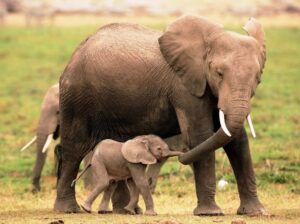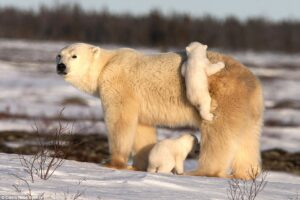By Dr. Beth Leermakers
Many mothers put “time to myself” high on their list of preferred mother’s day gifts. That’s not surprising, since being a mother is a full time job without any sick leave or paid time off. Animal moms also devote considerable time and energy to caring for their young. I recently fostered a mama dog and her four newborn puppies. For six long weeks, Roxy spent her entire days and nights feeding and cleaning up after her babies. She only left them a few times a day for brief bathroom breaks. The arrival of teeth made nursing painful, particularly when the puppies mistook her ear for a nipple. Roxy was ready to say goodbye to her puppies when they were weaned at six weeks, and I couldn’t blame her.

Photo courtesy of Somepets.com
Mother dogs, with their 63-day pregnancy and six weeks of neonatal care, have it easier than many other animal species. In honor of Mother’s Day, here’s a shout out to the extraordinary care-giving provided by a few animals.
Special meals. Elephants have the longest gestation period of all mammals — almost 22 months. When the mother gives birth, other elephants form a protective circle around her. The mother and other females help the newborn calf stand up immediately. The calf must stand up to be nursed, and his mother encourages him to start nursing right away.
Calves depend almost entirely on milk (from their mother and other females in the herd) for the first six months, drinking about two gallons a day. An elephant mother’s milk changes four times during the weaning process to meet the baby’s needs. During her calf’s painful teething process, an elephant mother’s milk adapts to soothe the baby. She changes her diet to include plants with anti-inflammatory properties to help the baby cope with incoming teeth.
Between 4-6 months, calves start eating grass and leaves and are gradually weaned from milk. Calves aren’t completely weaned until they’re more than two years old and weigh about 2000 pounds. Other females in the herd share in the child care responsibilities. Elephant moms teach their babies how to defend against predators, navigate steep embankments and pick the best plants for eating. Female elephants stay with their herd their entire lives, while males leave home between age nine and 18.
Chauffeur service. After an 8 1/2-month pregnancy, orangutan females give birth on their nest — often more than 100 feet up in the trees. That gives new meaning to the phrase “high risk delivery.”
Female orangutans build their delivery nest carefully to accommodate their pregnancy weight gain and keep the newborn from slipping through a crack.
Orangutans are the slowest mammals to grow up. Baby orangutans are completely dependent on their mother for food and transportation for two years. Mothers often breast feed their young until they are six or seven years old. The orangutan baby clings to her mother’s stomach, side or back while she moves through the trees, and mama never puts her little one down. Mothers sometimes carry their children until they are five years old.
Fighting her son’s battles. Female orcas devote a considerable amount of time and energy to raising their young. Orcas carry their one calf for 17 months, then give birth and nurse the calf for one to two years. Orca offspring stay with their mother’s pod forever, so a mother’s job is never really done. Male orcas — true mama’s boys — are particularly dependent on their mother. One study of 600 orcas found that young males were three times more likely to die the year after their mother’s death than males whose mothers were still alive. Older males (30 years) were eight times more likely to die after their mother died. Their mother’s death didn’t affect young female orcas, but older females were 2.7 times more likely to die after their mother’s death. Researchers speculate that sons may suffer more from losing their mother because she helps her adult sons hunt and fight off aggressive whales.

Photo courtesy of WhiteWolfPack.com
Pack on the pounds during pregnancy. Polar bears must gain 440 pounds during their 8-month pregnancy to prevent their body from reabsorbing the fetus. A polar bear has an easy delivery. She digs a maternity den, usually in a snowdrift, and enters a hibernation-like state where she doesn’t eat for two months. She actually sleeps through the birth of her cubs (usually one or two per litter). Mother polar bears nurse their cubs for up to 30 months. Cubs learn to hunt by watching their mother. Cubs can catch a seal every five or six days by the time they’re two years old. Unlike elephants, orangutans and orcas, polar bear cubs’ time with mama is limited. When her cubs are about 2 and 1/2 years old, the female polar bear is ready to mate again. The mother polar bear or her male suitor chases the cubs away, leaving them to fend for themselves.
Kudos to the human mothers who supervised their children’s remote schooling for months. Carrying your child on your back for five years seems easy in comparison.
Happy Mother’s Day!
